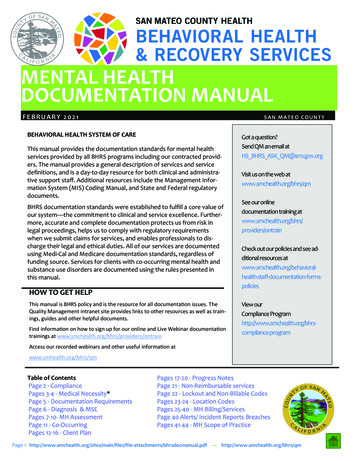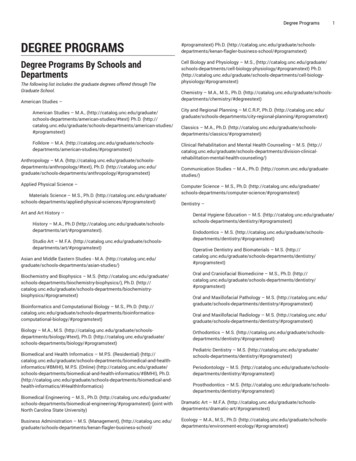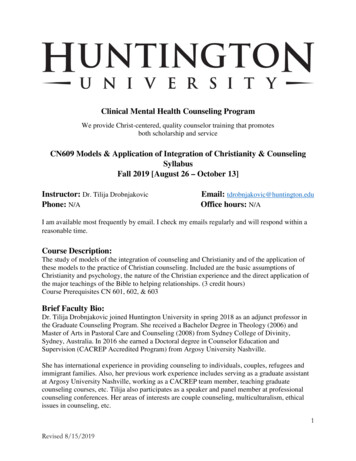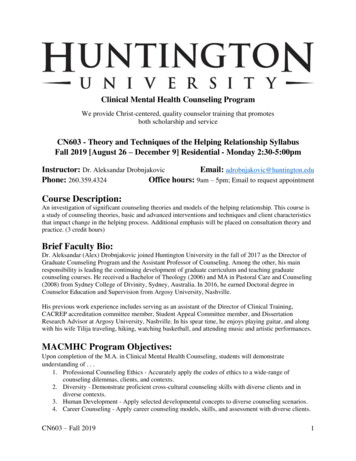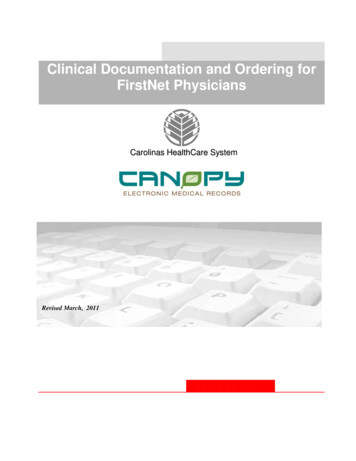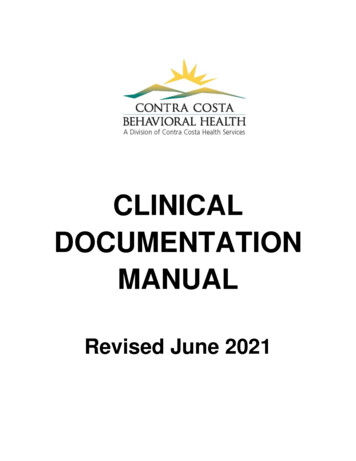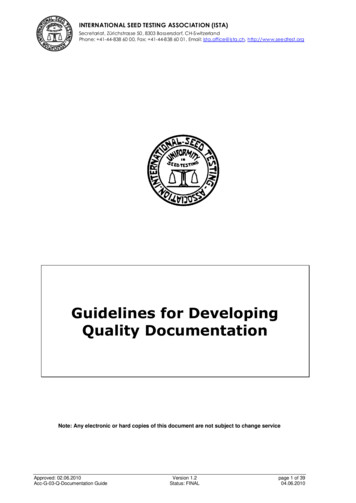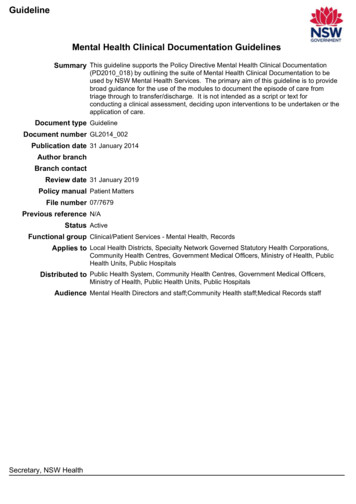
Transcription
GuidelineMental Health Clinical Documentation GuidelinesSummary This guideline supports the Policy Directive Mental Health Clinical Documentation(PD2010 018) by outlining the suite of Mental Health Clinical Documentation to beused by NSW Mental Health Services. The primary aim of this guideline is to providebroad guidance for the use of the modules to document the episode of care fromtriage through to transfer/discharge. It is not intended as a script or text forconducting a clinical assessment, deciding upon interventions to be undertaken or theapplication of care.Document type GuidelineDocument number GL2014 002Publication date 31 January 2014Author branchBranch contactReview date 31 January 2019Policy manual Patient MattersFile number 07/7679Previous reference N/AStatus ActiveFunctional group Clinical/Patient Services - Mental Health, RecordsApplies to Local Health Districts, Specialty Network Governed Statutory Health Corporations,Community Health Centres, Government Medical Officers, Ministry of Health, PublicHealth Units, Public HospitalsDistributed to Public Health System, Community Health Centres, Government Medical Officers,Ministry of Health, Public Health Units, Public HospitalsAudience Mental Health Directors and staff;Community Health staff;Medical Records staffSecretary, NSW Health
GUIDELINE SUMMARYMENTAL HEALTH CLINICAL DOCUMENTATION GUIDELINESPURPOSEThis Guideline supports the Policy Directive Mental Health Clinical Documentation(PD2010 018) by outlining the suite of Mental Health Clinical Documentation to be usedby NSW Mental Health Services. The primary aim of this Guideline is to provide broadguidance for the use of the modules to document the episode of care from triagethrough to transfer/discharge. It is not intended as a script or text for conducting aclinical assessment, deciding upon interventions to be undertaken or the application ofcare.KEY PRINCIPLESMental Health Clinical Documentation is separated into Core (required in allcircumstances and clinical settings) and Additional modules (to be undertaken whenclinically indicated) to be applied across the episode of care. The modules interrelatesuch that completion of the Core modules informs what Additional modules to documentfurther assessments are required and such that the clinical record as documentedthrough the clinical documentation forms a coherent narrative about the episode of care.The suite of Clinical Documentation Modules are to be viewed as a tool for recordingassessments and care provided and are not a script for undertaking these procedures.The modules are a place to document clinical information and are not a substitute forclinical skills, training, supervision or judgement.USE OF THE GUIDELINEThis Guideline should inform the use of the suite by clinicians in mental health and othersettings and provides advice on the intent and process of the development of thedocuments. The Guideline provides advice on when to complete individual ClinicalDocuments and where the results of a thorough clinical assessment should be recordedto allow consistency across episodes of care and between clinical records.REVISION HISTORYVersionJanuary 2014GL2014 002GL2008 016Approved byDDG SystemPurchasing andPerformanceDDG StrategicDevelopmentAmendment notesAmended GL2008 016 to include Metabolic MonitoringModuleATTACHMENTS1. Mental Health Clinical Documentation: Guidelines.GL2014 002Issue date: January-2014Page 1 of 1
Mental Health Clinical Documentation GuidelinesGUIDELINEIssue date: January-2014GL2014 002
Mental Health Clinical Documentation GuidelinesGUIDELINECONTENTS1BACKGROUND .11.1 . About this document.11.2 . Key definitions .11.3 . Overview of Clinical Documentation modules .31.4 . Policy framework .42CORE MODULES .42.1 . Triage .52.2 . Assessment.62.3 . Care Plan .82.4 . Review .92.4 . Transfer/Discharge Summary .103ADDITIONAL MODULES .102.1 . Physical Examination .112.2 . Metabolic Monitoring .132.3 . Physical Appearance.152.4 . Risk Assessment .162.4 . Substance Use Assessment.172.1 . Family Focussed Assessment (COPMI) .182.2 . Functional Assessment (Older People) .192.3 . Screening for Domestic Violence.202.4 . Cognitive Assessment (RUDAS) .212.4 . Cognitive Assessemnt (3MS/MMS) .222.4 . Consumer Wellness Plan .234GENERAL PRINCIPLES FOR COMPLETION OF THE MODULES . 235FUTURE DEVELOPMENTS .24GL2014 002Issue date: January-2014Contents page
Mental Health Clinical Documentation GuidelinesGUIDELINE1BACKGROUND1.1 About this documentThese Guidelines have been developed to facilitate the implementation of the redesigned MentalHealth Clinical Documentation by public mental health services.The primary aim of the current document is to provide broad guidelines for the use of themodules to document an episode of care from triage through to transfer/discharge. It is notintended as a guideline or text on conducting a clinical assessment. The modules are a place todocument clinical information; they are not a substitute for skills, training, supervision orjudgement.The Guidelines provide the following information on each module:HeadingDescriptionPurposeTarget servicesCompletion requirementsOutlines the clinical situation for which the module is intended.Outlines the services and settings expected to use the module.Outlines any prerequisite skills or knowledge required for the completion of themodule.Outlines educational and/or other resources that have been, or are being, developedto support the completion of the module.Highlights any issues related to the use of the modules by these servicesAssociated resourcesIssuesforCAMHSSMHSOP servicesCompletion tipsandProvides information to guide clinicians in the completion of particular informationdomains.The Guidelines replace those contained in the Your Guide To MH-OAT (2004) regarding the useof standardised mental health clinical documentation. The Guidelines reflect therecommendations of the participants in the redesign process, along with the feedback receivedfrom participants in the field testing of the draft redesigned modules. Further input into theGuidelines was received from the following sources: Informal consultations undertaken state-wide via email with clinicians, managers andother key stakeholders during May 9 -June 9 2008;Forum undertaken with MH-OAT and MHIDP personnel on May 26 and 27 2008;Feedback from over 140 clinicians, managers and other key stakeholders during statewide Information Sessions on the redesigned modules undertaken from May 28 to June 42008;Feedback from relevant NSW Health personnel.It is anticipated that Local Health District (LHD) protocols would further define the completion ofthe modules, reflecting consideration of the nature of the clinical process being undertaken by theservice, and LHD business processes. The completion of the modules should also always beguided by the clinician’s informed judgement regarding the consumer’s clinical status and needsat the time. Progress notes can be used to supplement information documented in the modulesas appropriate.1.2 Key definitionsMental Health Clinical Documentation is separated into Core (required in all circumstances andclinical settings) and Additional modules (to be undertaken when clinically indicated) to be appliedGL2014 002Issue date: January-2014Page 1 of 24
Mental Health Clinical Documentation GuidelinesGUIDELINEacross the episode of care. The modules interrelate such that Core modules inform whatAdditional modules to document further assessments are required and such that the clinicalrecord as documented through the clinical documentation forms a coherent narrative about theepisode of care. Core Modules: Triage, Assessment, Care Plan, Review and Transfer/DischargeSummary.These are to be used for all settings and age groups. Additional Modules: Physical Examination, Metabolic Monitoring, Physical Appearance,Risk Assessment, Substance Use Assessment, Family Focused Assessment (COPMI),Functional Assessment (Older People), Screening for Domestic Violence, CognitiveAssessment (RUDAS), Cognitive Assessment (3MS/MMS) and the Consumer WellnessPlan.These are to be used as appropriate to the clinical situation.The logic of the ‘core’ and ‘additional’ module relationship is that the core module is the primarylocation for clinical documentation; the ‘additional’ modules are available for additionalassessment and documentation support for specific information domains. This approach givesclinicians and services greater flexibility in terms of choosing the degree of support and structurethat they require for particular information domains. It also affords clinicians and services greaterflexibility in terms of the documentation of information gathered over the course of theassessment process. The ‘additional’ modules are also available for use at points of care otherthan assessment, such as review and transfer/discharge, affording clinicians and services greaterflexibility in the documentation of the episode of care.Clinicians should use the modules as tools to record the information in a structured format, ratherthan as assessment and clinical practice guides, with clinical judgement paramount in guidinginformation gathering.GL2014 002Issue date: January-2014Page 2 of 24
Mental Health Clinical Documentation GuidelinesGUIDELINE1.3 Overview of Clinical Documentation modulesGL2014 002Issue date: January-2014Page 3 of 24
Mental Health Clinical Documentation GuidelinesGUIDELINE1.4 Policy frameworkThe use of standardised Mental Health Clinical Documentation is mandated under PolicyDirective Mental Health Clinical Documentation (PD2010 018).Components of the Assessment, Physical Examination and Metabolic Monitoring modulessupport Policy Directive Provision of Physical Health Care within Mental Health Services(PD2009 027) and Guideline Physical Health Care of Mental Health Consumers Guidelines(GL2009 007)2CORE MODULESTRIAGEPurposeThe Triage module has been developed for use in both face-to-face and telephone triage.Target servicesAll mental health services conducting telephone or face-to-face triage.Completion requirementsThe Triage module can be completed by any appropriately qualified and experienced mentalhealth professional.Associated resourcesThe Crisis Triage Rating Scale (CTRS) (Bengelsdorf et al., 1984) is provided as a laminatedresource and can be used as a guide in informing decision making about the urgency ofresponse. The Scale assesses the consumer on three factors: (A) whether they are a danger tothemselves or others, (B) their support system, and (C) their ability to cooperate. The clinicianselects the score under each factor that best describes the consumer’s presentation. Scoresrange from 1 to 5 for each factor, resulting in a maximum total score of 15 (A B C). Lowerscores indicate more significant crisis. The Scale was originally based on a telephone triage scaleand has been demonstrated to be a useful tool in determinations of the need for hospitalisation,with this indicated by scores below 9. It has since been modified and expanded to cover a rangeof ‘urgency of response’ options in inpatient and community settings. This Scale should be usedby a clinician in conjunction with the available triage information to make an informed decisionabout the urgency of response.Issues for CAMHS and SMHSOP servicesNil.Completion tips Any ‘Alerts/Risks’ identified during triage should be summarised in the text box on page 1after the triage is completed. Some examples: ‘High risk for suicide’, ‘Fire risk – smokes inbed’, ‘Fall risk due to hypotension’. ‘Communication issues’ includes issues such as l
Mental Health Clinical Documentation Guidelines . The suite of Clinical Documentation Modules are to be viewed as a tool for recording assessments and care provided and are not a script for undertaking these procedures. The modules are a place to document clinical information and are not a substitute for clinical skills, training, supervision or judgement. USE OF THE GUIDELINE . This .
